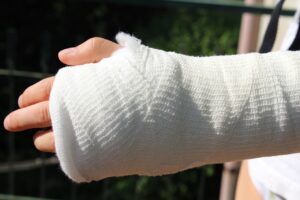Written by Taylor Woosley, Science Writer. Findings of a 4-week study with an intervention of chicory seed syrup 10 cc three times daily, along with one placebo capsule, and the control group of placebo syrup 10 cc three times daily with one Livergol capsule (140 mg of silymarin per capsule) improved liver enzymes in burn patients at day 15 compared to baseline.
 Burn injuries represent the fourth most common type of trauma worldwide1. They are caused by heat, electricity, friction, chemicals, or radiation and are commonly divided into superficial, superficial partial-, deep partial- and full-thickness injuries2. Burn injuries, particularly severe burns, are accompanied by an immune and inflammatory response, metabolic changes, and distributive shock that can be challenging to manage3. Multiple organ failure is a leading cause of death after burn injury resulting in excessive systemic and localized inflammation directly contributing to end organ damage4.
Burn injuries represent the fourth most common type of trauma worldwide1. They are caused by heat, electricity, friction, chemicals, or radiation and are commonly divided into superficial, superficial partial-, deep partial- and full-thickness injuries2. Burn injuries, particularly severe burns, are accompanied by an immune and inflammatory response, metabolic changes, and distributive shock that can be challenging to manage3. Multiple organ failure is a leading cause of death after burn injury resulting in excessive systemic and localized inflammation directly contributing to end organ damage4.
The phenolic compounds present in the leaves of chicory (Cichorium intybus L.) exert multiple health benefits, including hepatoprotective and antioxidant properties5. Furthermore, milk thistle (Silybum marianum), and its extract silymarin, yield significant anti-inflammatory properties through its interaction with various receptors and growth factors, including apoptotic proteins and inflammatory cytokine gene expression6.
Keshavarzi et al. conducted a double-blind, randomized, controlled study to investigate the potential effect of C. intybus on liver enzyme variation in burn patients. Subject inclusion consisted of being between the ages of 20 and 75 years who were experiencing 2nd and 3rd degree burns, with extent of burns between 10 and 50%. Personal and demographic information was collected from participants at baseline. Fasted blood samples were obtained to assess aspartate aminotransferase (AST), alanine transaminase (ALT), alkaline phosphatase (ALP), albumin, creatinine (Cr), blood urea nitrogen (BUN), blood sugar (Bs), white blood cell count (WBC), hemoglobin (Hb), and platelet (Plt) levels.
Subjects were divided into intervention and control groups for a 4-week intervention. Participants in the intervention group received chicory seed syrup 10 cc three times daily, along with one placebo capsule (140 g roasted corn flour) two times daily. Subjects in the control received placebo syrup 10 cc three times daily and Livergol capsules (140 mg of silymarin per capsule) two times daily. All participants took their assigned syrup until discharge and liver enzymes were checked every three days and one week after discharge.
60 subjects enrolled in the study and 42 participants were included in the final analysis (20 women and 22 men, mean age of 40.5 years). No significant differences were noted between groups regarding baseline demographic criteria and blood biomarkers. Results of the study show that, although no significant difference was noted between groups regarding changes in liver enzymes, each group experienced decreased levels of liver enzymes on the 15th day of the intervention compared to baseline. Cichorium intybus L. (chicory) and silymarin may be an effective treatment to improve liver enzymes in burn patients. Study limitations include the small sample size and short study duration.
Source: Keshavarzi, Abdolkhalegh, Rahimeh Akrami, Mohammad M. Zarshenas, Saeid Zareie, Tayyeb Ghadimi, Ali Najafi, Mahsa Rostami Chijan, Azizallah Dehghan, and Elham Zarenezhad. “Evaluation of the Effect of Cichorium intybus L. on the Liver Enzymes in Burn Patients: A Randomized Double-Blind Clinical Trial.” International Journal of Clinical Practice 2024 (2024).
© 2024 Abdolkhalegh Keshavarzi et al. Tis is an open access article distributed under the Creative Commons Attribution License, which permits unrestricted use, distribution, and reproduction in any medium, provided the original work is
properly cited.
Click here to read the full text study.
Posted May 2, 2024.
Taylor Woosley studied biology at Purdue University before becoming a 2016 graduate of Columbia College Chicago with a major in Writing. She currently resides in Glen Ellyn, IL.
References:
- Knuth CM, Auger C, Jeschke MG. Burn-induced hypermetabolism and skeletal muscle dysfunction. American journal of physiology Cell physiology. Jul 1 2021;321(1):C58-c71. doi:10.1152/ajpcell.00106.2021
- Burgess M, Valdera F, Varon D, Kankuri E, Nuutila K. The Immune and Regenerative Response to Burn Injury. Cells. Sep 29 2022;11(19)doi:10.3390/cells11193073
- Jeschke MG, van Baar ME, Choudhry MA, Chung KK, Gibran NS, Logsetty S. Burn injury. Nature reviews Disease primers. Feb 13 2020;6(1):11. doi:10.1038/s41572-020-0145-5
- Curtis BJ, Shults JA, Boe DM, Ramirez L, Kovacs EJ. Mesenchymal stem cell treatment attenuates liver and lung inflammation after ethanol intoxication and burn injury. Alcohol. Nov 2019;80:139-148. doi:10.1016/j.alcohol.2018.09.001
- Krepkova LV, Babenko AN, Lemyaseva SV, Saybel OL, Sherwin CM, Enioutina EY. Modulation of Hepatic Functions by Chicory (Cichorium intybus L.) Extract: Preclinical Study in Rats. Pharmaceuticals (Basel, Switzerland). Oct 16 2023;16(10)doi:10.3390/ph16101471
- Calderon Martinez E, Herrera D, Mogan S, et al. Impact of Silymarin Supplements on Liver Enzyme Levels: A Systematic Review. Cureus. Oct 2023;15(10):e47608. doi:10.7759/cureus.47608
